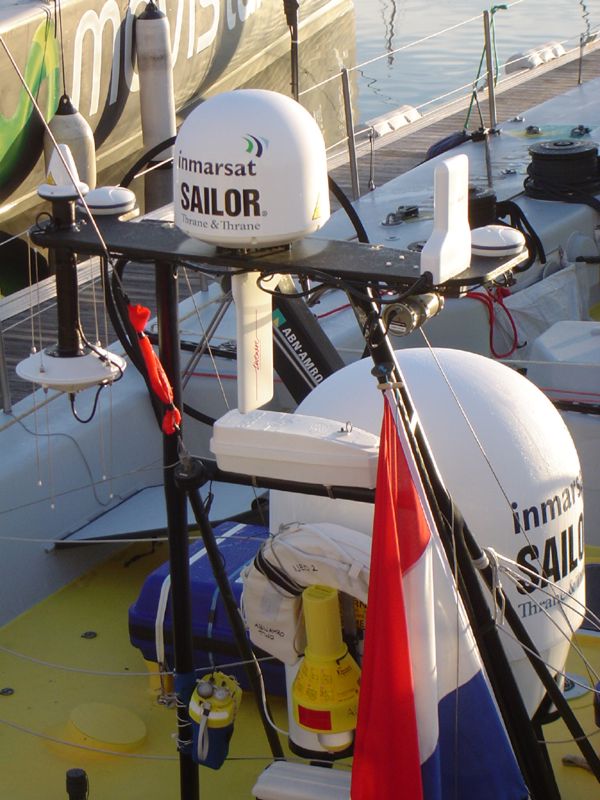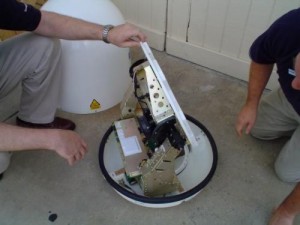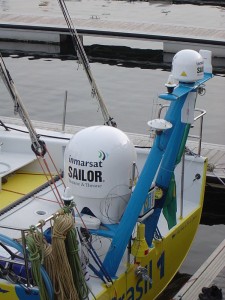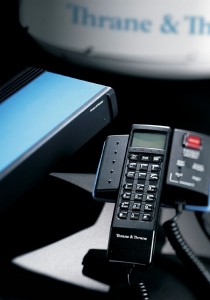Inmarsat takes the lid off the Volvo Ocean Race 2005
Inmarsat has supplied communication services for the Round the World Yacht Race since 1993 and this year they are the official sponsor of mobile satellite communications for the Volvo Ocean Race 2005.
 Inmarsat has supplied communication services for the Round the World Yacht Race since 1993 and this year they are the official sponsor of mobile satellite communications for the Volvo Ocean Race 2005.
Inmarsat has supplied communication services for the Round the World Yacht Race since 1993 and this year they are the official sponsor of mobile satellite communications for the Volvo Ocean Race 2005.
It is four years since the last 'Everest of Sailing' has taken place and in that time the race has changed significantly. The latest yachts in the Volvo Ocean Race are cutting edge, carbon fibre lightweight flyers capable of world record speeds. It is widely believed that these boats will be at least 20% faster than their predecessors. Although this represents a massive step ahead in speed, in the last four years the speed of data communication coming from the yachts has increased by over 100%. The Inmarsat Fleet F77 satellite communications system will allow the viewer at home to see, hear and read information that has never been broadcast with such volume and clarity before.
Although this represents a massive step ahead in speed, in the last four years the speed of data communication coming from the yachts has increased by over 100%. The Inmarsat Fleet F77 satellite communications system will allow the viewer at home to see, hear and read information that has never been broadcast with such volume and clarity before.
Each boat is fitted with nine hi-tech mini-cameras and microphones capturing all of the action and the human drama as it unfolds;
There is a high-tech camera at the back of the boat which is continually running, if a stunning event occurs the helmsman can hit a button right next to him recording the action ten minutes before and ten minutes after an event.
The video quality will be 400% better than four years ago, allowing TV quality footage to come from the boats; as part of the rules of the race, each team must send 20 minutes of video per week and regular emails to the race headquarters. This includes a personal diary coming from the boats that is sent via a camera pointing at the yacht's single piece of sanitary equipment! The diary room in Big Brother was never, shall we say, so intimate.
But there are far more serious uses for the advanced satellite communications that Inmarsat is providing. Whilst each yacht has crew members trained as medics, they are not qualified doctors. Hurtling around the world in racing yachts is a highly dangerous occupation and accidents can, and could well, happen; already while training, sailors have broken limbs and sustained hospitalising injuries. In the past there was little the crew could do, save immobilize the casualty in a bunk with a supply of pain killers or applying fairly basic medical treatment. With internal injuries or unusual symptoms, a medical diagnostic was very difficult for doctors onshore, but that has changed significantly in this year's race. Each boat has enough medical kit to carry out a small operation but more significantly, the medics onboard can be talked through procedures by doctors with a telephone and video link. This facility could make the difference that stops a yacht pulling out of the race or in the worst case scenario the difference between life and death.
Whilst each yacht has crew members trained as medics, they are not qualified doctors. Hurtling around the world in racing yachts is a highly dangerous occupation and accidents can, and could well, happen; already while training, sailors have broken limbs and sustained hospitalising injuries. In the past there was little the crew could do, save immobilize the casualty in a bunk with a supply of pain killers or applying fairly basic medical treatment. With internal injuries or unusual symptoms, a medical diagnostic was very difficult for doctors onshore, but that has changed significantly in this year's race. Each boat has enough medical kit to carry out a small operation but more significantly, the medics onboard can be talked through procedures by doctors with a telephone and video link. This facility could make the difference that stops a yacht pulling out of the race or in the worst case scenario the difference between life and death.
In cases of medical assistance or emergency, race doctors and medical staff are on standby 24 hours a day 7 days a week whilst the yachts are competing. The medical team are able to be in direct contact with the yachts by using the Inmarsat satellite communications systems on board, which is vital.
Dr. Tim Spalding, Chief Medical Advisor for the Volvo Ocean Race, explains how valuable this link is:
"If it all gets too complicated for those at sea, help is on hand from the British Antarctic Medical Unit at Derriford Hospital in Plymouth. This is probably the most advanced facility in the world in terms of talking to people who are not comprehensively medically trained."
The race's travelling medical co-ordinator, Timo Malinen, has worked for Volvo Ocean Race for the past two races and is on call should any of the teams require medical assistance.
"I am a great believer in keeping things as simple as possible; not too many moving parts, as in my field there is no room for error. I have to say that the communication systems on board for this race give better quality pictures and the possibility of video as well.
Also the communication coverage is wider and more reliable which makes me feel more confident that I will be able to contact any of the yachts should the need arise."
The Volvo Ocean Race is a massive test of the sailors' mental and physical endurance; there are no auto-pilots, every one of the 31,250 miles must be self-steered and every sail change will require the full crew on deck regardless of the time of day or night. Sleep is a luxury and at times the crew will have little rest for days at a time. The temperatures endured can range from a tropical +40? to a wind-chill factor of -30? in iceberg territory, food is freeze-dried and re-hydrated. Because of the need for weight saving nobody will have personal effects on board, and indeed crews will not shower or change clothing for weeks on end. All this adds up to stress from fatigue and the horrendous conditions. Research into sports science has shown effective stress management has a major positive effect on the performance of athletes in any sport, especially in events such as offshore yacht racing. Timo Malinen believes that personal contact between the racing sailors and shore crew or loved ones back at home is very important:
"The communications systems onboard provide human contact and that sort of assistance cannot really be quantified but it is a tremendous asset. It allows the medical team onshore to monitor and if necessary take control of a situation. You can have the best machinery and medicines available onboard, but human contact from the Volvo team or friends and family is a great tool"
The high performance Fleet F77 is supported up by two other systems that the vessels use for other forms of communication - Fleet F33 is a smaller version of the F77 and is suitable for voice, fax and data transmissions, and Inmarsat C is designed for transmitting text such as the yacht's positioning data; the latter is also used to transmit the data that will be used by Virtual Spectator to recreate the race on the internet in amazing detail.
Another major change to this year's Volvo Ocean Race is in the vital area of weather information; in previous races, onboard navigators scoured the internet for detailed information via a slower satellite connection. Some of these services will be new for the crews in the race, but it's what Inmarsat has been providing to the broader maritime community since its inception in 1979. "Our heritage is in maritime communications," said the company's Chief Operating Officer, Michael Butler, "so we know something of the challenges that these intrepid sailors are about to face. We're delighted to be a part of bringing that action to the race's many spectators, and helping competitors keep safe."
Some of these services will be new for the crews in the race, but it's what Inmarsat has been providing to the broader maritime community since its inception in 1979. "Our heritage is in maritime communications," said the company's Chief Operating Officer, Michael Butler, "so we know something of the challenges that these intrepid sailors are about to face. We're delighted to be a part of bringing that action to the race's many spectators, and helping competitors keep safe."
"This gives us an opportunity to support an exciting event, with a global profile, and showcase the range of services we offer for both the yachting and broader maritime communities," he concluded.
This is Steve Hayles's fourth race as navigator aboard Volvo 70 Team Ericsson and he knows better than anyone just how important the satellite communications are on board. Ericsson won the first event of the Volvo Ocean Race 2005 and Inmarsat reporter Louay Habib managed to talk to Steve at their victory celebration in Sanxenxo, Northern Spain:
"Navigational aids have changed unbelievably since the first race in 1973. These aids have not only been of immense use to crew, they have also allowed the spectator to get an impressive overall picture of the race," said Steve.
"Things have moved on fantastically in the area of communications. A lot of the developments help us onboard to make better decisions. For me the best thing about these sorts of programs is the feeling that you are pushing everything to the limit and the navigation aids are an inevitable part of that.
Also, the more people that can 'access' the race is for the better in my view. Certainly without the public involved the race would struggle to happen, as sponsors are crucial to the future for such an event. One thing that I can tell you very confidently is that in previous events, no-one has ever really captured any of the really hairy moments from onboard. When the whole fleet is close in the Southern Ocean and it's getting near the limit of the boats' and crews' ability, there are moments when the true nature of the race really sticks in your mind".
Steve said, "We now have the potential to lift the lid off the Volvo Ocean Race for the people following it at home, and hopefully show the world what this race is all about."












